Menus
- The school of fans (of speed)
- Introduction
- Presentation
- In the saddle
- In the city
- Motorway and expressways
- Departmental
- Track
- Comfort and duo
- Consumption
- The accessories
- Conclusion
The school of fans (of speed)
KTM hits hard with its RC 390 by offering the most efficient machine in the A2 segment. Easy and fun while remaining very easy to use on a daily basis, it can even appeal to more experienced drivers on a tight budget or looking for a sports car with “human” performance….
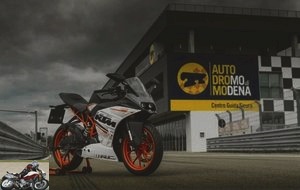
Introduction
The presentation of the new RC 390 corresponds to a key moment in KTM history. First of all, this is the first year that the Austrian manufacturer has sold more road machines than off-roaders. A small feat of which the orange men are particularly proud knowing that they are world leaders in the nipple machine segment and that their first road machine, the SuperDuke, only appeared in 2005 … sales this year are up 28% and June 2014 was the most successful month in KTM history.
Moreover, the Mattighofen firm has just invested 100 million euros in its factory, in particular with an R&D center whose surface area will increase by 1000 m2. In short, all the indicators are green and KTM does not intend to stop there. For Thomas Kuttruf, communication manager of KTM, the RC 390 is a “milestone bike” (or significant machine in French in the text) in the history of the brand just like a Super Duke 1290 R. Seen from France, the term may make you smile, but at the global level, the expectations placed in this “little” sports car weigh heavily, both in terms of images and sales volumes. On the old continent, it will target A2 license holders looking for a sports machine. And in emerging countries, it will play the role of flagship of the range. Easy when you know that in Asia, a 200 is already considered a “big cube”.

As a cherry, KTM finally holds with this RC 390 the bridge that it lacked between its commitment to the Moto3 GP and its road range. Well, it’s less glamorous than MotoGP, I grant you, but the Austrians are playing on two fronts with the launch in several countries (including France) of an RC 390 Cup that will allow you to set foot in the stirrup of young talents … It is also no coincidence that KTM invited us to Modena – located a stone’s throw from Maranello, home of Ferrari – to test its novelty on the road AND on the circuit..
Presentation
The RC 390 is common base with its cousin Duke 390 which does not mean that KTM was content to stick a fairing and a pair of bracelets on the roadster. Among the less visible modifications, one will note repositioned footrests (in particular to gain ground clearance), a closed column angle of 1.5 ° as well as a wheelbase shortened from 1367 to 1340 mm. As a side effect, the weight distribution is found to be quite upset with a much more loaded front end supporting almost half of the motorcycle / pilot assembly against only 46% on the Duke. On the scale this also translates into a weight gain of 8 kg, or 147 kg dry despite a specific tank containing a liter less than Miss Duke. It’s heavy a fairing…

For the rest, it’s a cut and paste of the ingredients of the roadster. The 375 cm3 hyper-square single-cylinder still develops 44 horsepower at 9,500 rpm and 35 Nm of torque at 7,250 rpm and the servicing spaces have not budged, still 7,500 km … The good news, because as the weight has increased, the mono no longer needs to be restrained for A2 licenses in order to respect the maximum weight / power ratio of 0.2 kW / kg. Same remark for peripherals. The fork is still a non-adjustable 43 mm diameter WP (but firmed up to compensate for the overweight on the front axle) associated with a simple 300 mm disc and a 4-piston radial caliper, all under the control of a Bosch disconnectable ABS latest generation. Ditto for the rear shock absorber, which remains adjustable only in preload despite the sportier vocation of the RC. For tires, KTM also keeps the same Metzeler Sportec M5 fitment in 110/70 and 150/60 on 17-inch rims.
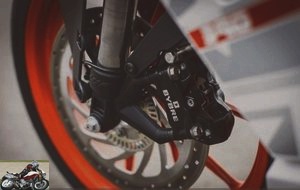
On the design side, the Kiska studio is still in charge so the design is anything but consensual (we speak of “divisive” design in the automobile), it is an assumed choice. It should be noted all the same that this small RC – and its clones 125 and 200 – inaugurates a passenger seat of a new kind, molded from a single piece of foamed plastic mimicking the rigid backrest of a single-seater sports car, position lights front and rear LEDs and a specific rear shell revealing the rear loop of the tubular trellis frame. Ah! I was going to forget the turn signals integrated into the mirrors with the key to a more refined line and time saved for disassembling things that break and are expensive during use on the track.
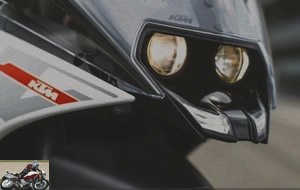
In the saddle
With a saddle height of 820 mm -2 cm more than a Duke, the RC 390 remains accessible to small riders. From the height of my meter seventy, my heels barely lifted from the ground. As for the bracelets, positioned at the level of the triple tree, they tilt the bust in a more GT position than really sporty. The footrests are also not too high and the driving position will accommodate all sizes. Too bad that, as on the Duke, the levers are not adjustable.
The dashboard, also common, logically calls for the same criticisms. We are entitled to a plethora of information: speed, rpm, odometer, trips, time, engine temperature, fuel gauge, remaining range, average consumption, kickstand indicator light, side …. but the whole is difficult to read (especially the tachometer). KTM may have read our review of the Duke 390 (or listened to its owners) and the window dedicated to ephemeral information such as average consumption no longer resets each time the ignition is switched off as it was on the roadster. So much the better, it required systematically fiddling with the dashboard buttons to fall back to the desired display. A good point therefore.
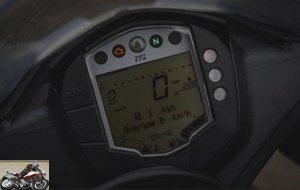
Another plus, the already very good finish of the Duke goes up a notch here. Not that KTM has made a particular effort on this machine, but the unsightly wires of the electrical circuit are now hidden behind the fairing. Combined with the “luxurious” equipment in this segment (inverted fork, radial braking, cast swing arm, etc.), the RC 390 is undoubtedly the most rewarding machine in its segment..
In the city
With barely 150 kg with full tank, the RC390 handles like a ballerina. Lively, agile, light, the KTM is at ease in the city. The driving position is never constraining and the suspensions retain the excellent firmness-comfort compromise of the roadster. No need to fear the compression of the vertebrae on the speed bumps or an organ descent on a pothole. The box, precise and with short deflections, accepts the passages on the fly with or without the clutch. The latter has also won smoothly. Slightly too hard on the Duke, it calls for no reproach here. Ditto for the pulling of the throttle, also improved. No need to twist your wrist to accelerate fully.
The turning radius is correct without more. Narrower than a Duke, the RC should also do better from the exercise of the lifts in line to have the pole at the red light and whatnot of the big metropolises. In short, that’s good on condition of maintaining the small mono above 3000 revolutions to avoid knocking, or even 4000 to benefit from times worthy of the name..
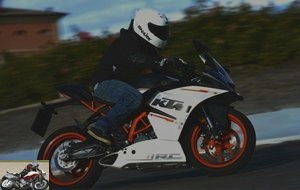
The only real downside comes from the mirrors, certainly very stylish but of which 50% of the surface only reflects the elbows, except when lying on the tank which is not the most practical in town. The future owners of RC 390 (or current, it all depends on when you read these lines, that’s the beauty of the net) are invited to give their opinion here fairing.
Motorway and expressways
The few motorway connections during our trip around Modena gave our small group of journalists the opportunity to exploit the full driving potential of this RC. No noticeable change in flexibility. We can go down to 2500 rpm on the first three reports, 3000 in 4th and 5th and finally 3500 rpm on the last report. Below, the mono growls and shows his displeasure by vibrating excessively. Apart from the lazy people of the left grip, keeping the rev counter as low is of no interest anyway as the pickups are anemic. After a few kilometers, the engine speed is instinctively maintained above 4000 rpm, the true operating threshold, which leaves a little more than 6000 revolutions of the operating range before the switch comes into action..
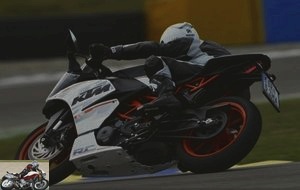
Although KTM has not announced any changes to its 375cc unit, the character of the single cylinder has evolved somewhat since the presentation of the Duke. The “turbo” side when passing 6500 rpm has faded. The single cylinder is more linear, but also seems fuller than in the past. The airbox specific to small RCs is probably at the origin of this change. Always so happy to climb in the towers, the Austrian mono grows more and more as it approaches the red zone. Despite a maximum power announced at 9500 revolutions, it does not regulate beyond and still pushes copiously (with regard to 44 horses) until the intervention of the breaker shortly after 10,000 rev / min.
In the game of Vmax, the RC 390 is able to block its speedometer at 177 km / h. In cruising mode at 130 km / h, the mono turns without forcing at 7100 rpm while distilling some vibrations in the footrests. This is not a problem for the pilot, unlike the consistency of the saddle, considered too hard in the long run by the majority of testers present. An “ergonomic” saddle available in the KTM Powerpart catalog should improve things for long motorway connections. At legal limits, the RC 390’s bubble deflects enough air over the shoulders and top of the helmet to relieve pressure on the wrists. Adults and sensitive necks can fall back on the optional racing screen which, despite its name, is higher than the original model..
Departmental
The hills overlooking Maranello and Modena proved to be the perfect playground for the RC 390. The liveliness and agility you glimpsed in town are still present when driving at a much more reprehensible pace. On the handlebars of the little sportswoman, everything is easy, obvious. The setting on the angle is done naturally and the front axle keeps all its directional power even when entering hard on the brakes. The suspensions, flexible at the start of the race, are a bit confusing for the first few kilometers, but allow formidable efficiency to be maintained when the asphalt deteriorates. Equipped with an excellent front / rear hydraulic tuning, the RC 390 never comes apart on bumps. In curves on big shocks, the rear can start to pump sometimes, but the whole remains healthy.
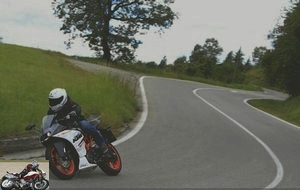
On the braking side, we would have liked a little more bite from the front radial caliper, especially when cold, but the power is there. As for the ABS, it is only intrusive on very hard braking and retains optimum slowing power when it kicks in. Then you have to integrate the instructions for use specific to mid-size sports cars: keep the tachometer in the last third, keep speed when entering a turn and take advantage of the general lightness to tighten a trajectory without getting the slightest heat. which closes.

The absolute performances are certainly not mind-blowing, but thus carried out, one can allow oneself with the RC 390 of the jokes prohibited with bigger cars. Over the kilometers, it is clear that the RC label is not usurped … At each turn, we say to ourselves that we could have entered stronger, taken more angle and accelerated earlier! KTM probably said the same thing to itself since at the end of our morning driving, we reached the Modena autodrome to push Miss RC into its last entrenchments in complete safety….
Track
The Modena track is perfectly suited to the size of the RC 390, a cross between Carole and Ledenon (but without drop) with just enough space to pass the sixth in the pit straight. After a quiet first session to understand the trajectories and braking zones, the RC 390 was once again totally at ease. Perfect for learning the basics of the track for a beginner, it will also appeal to more experienced “old” bikers since it gives the opportunity (rare nowadays) to exploit a machine to 100% of its potential. We therefore resume the instructions for use discovered on departmental, with even more application.
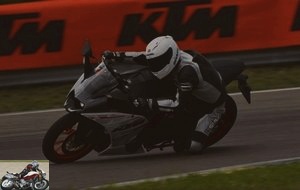
If the RC 390 has the means to make circles around a 600 roadster (at least on this route), it is imperative to lick its trajectories, work on your braking, force yourself to return as quickly as possible in the turns and sweat on the footrests to take advantage of the riquiqui weight in the changes of angle … Even rolling the knife between the teeth, this RC 390 remains healthy and always very fun to take. So much so that we quickly manage to rub the toe clips in almost every corner.
The track test also allows us to bring to light any faults that have hitherto been under our radar. The shock absorber, almost irreproachable on the road, is here a little too flexible and not sufficiently braked in relaxation in certain phases of piloting. In the many pif-paf of the Italian track, the braking / acceleration transition by passing from one maximum angle to the other makes the rear pump up and can cause slips during re-acceleration if we put the throttle back on before the machine is stabilized. on its supports. More experienced pilots, fed on electronic driving aids, will also need to be careful. Despite the excellent grip of the Metzeler Sportec M5 and the reasonable power, it is necessary to measure the arrival of the cavalry on the maximum angle (yes yes).

Another point of detail for chrono hunters, the brake lever lacks a little feeling to perfectly adjust the deceleration when entering the brakes, a critical phase in the piloting of a small displacement. On a more positive note, one will note finally the significant influence of the prestressing on the behavior. At maximum setting, the front axle, more loaded, gains noticeably in precision. In return, the lightened rear will slide a little earlier, a question of compromise … Rest assured, in the context of intensive track use, a pair of more efficient tires, aviation hoses and rear controls should be enough to erase the few complaints cited above.
Comfort and duo
The comfort chapter, already discussed in the city and departmental section, is excellent. Fortunately, since apart from the preload at the rear, the suspensions are devoid of adjustments. On the duo side, it will be necessary to put the preload to the maximum before boarding a passenger to recover a few centimeters of travel. The sandbag will also be better treated than the driver with a very soft and sufficiently wide seat in its front part and even large notches under the passenger shell acting as grab handles. !
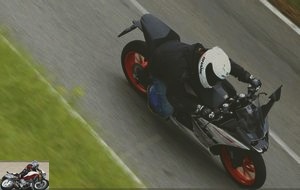
Consumption
Despite a not at all cushy pace, the road course resulted in an average consumption of 2.9 L / 100 km over a total distance of 96 km. Some colleagues have even managed to go down to 2.7 liters. On the track, however, it’s a different story since at the end of the day, several on-board computers (without resetting since the morning) displayed between 6.3 and 6.8 L / 100 km. With its 10 L tank, it is therefore possible for the RC 390 to exceed 300 km of autonomy, but those who will exploit its full potential on the track will have to provide an extra jerry can….
The accessories
It is usual at KTM, the Powerpart catalog is widely supplied and allows to orient the RC 390 towards a more GT or track orientation, without forgetting an avalanche of cosmetic odds and ends. In addition to the high racing screen (€ 66 incl. VAT) and the ergonomic saddle (€ 138 incl. VAT), there are front and rear protection castors (€ 36 incl. VAT), articulated and especially adjustable brake or clutch levers (99, 90 € TTC), saddle and tank bags (NC) or the clever disc lock integrated into the Radial Roadlock fork, rear controls and the inevitable Akrapovic pot (NC). All accessories are visible on the KTM website.
Conclusion
A fun and frugal engine, a healthy cycle part and an obvious grip, the KTM has significant advantages to appeal to sports apprentices in the A2 category. No more radical than a Duke, or even more versatile thanks to its fairing, it will accommodate as much a daily commuting as it does Sunday trips or occasional escapades on the track. Sold € 5,790 with its original ABS, it is € 190 more expensive than a Kawasaki Ninja 300 also equipped with anti-lock braking, but in terms of equipment (braking, pneumatic mounting, suspensions, etc.) inferior. There remains the alternative CB 500 R, more versatile on a daily basis, but much less sporty. But its fiercest competitor will probably be the 390 Duke (€ 600 cheaper) and for the “non A2” the now unavoidable Yamaha MT-07, certainly not at all on the same niche, but whose price is canon of 5,999 € risk all the same to shade him.
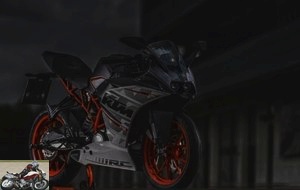
Strong points
- Road holding and lightness
- Braking power
- quality-price-equipment ratio
- Fun and frugal single cylinder
Weak points
- Lack of cold front brake bite
- Rear shock absorber too soft in extreme use
- Readability of the dashboard
- wing mirror
The technical sheet of the KTM RC 390
Competition: Honda CB 500 R, Honda CBR 250/300, Kawasaki Ninja 250R / 300
Related articles
-
A mid-size road trail that has everything of a great … test over 2,500 km Twin cylinder in line, 649.3 cm3, 61 hp and 62 Nm, 213 kg, 6,250 euros The…
-
Waiting for the new Hornet… No, the CB 650 F is not the replacement for the Hornet. Healthy, easy and fast enough, it is intended primarily for…
-
V2, 1301 cm3, 177 hp at 9750 rpm, 141 N.m at 7000 rpm, 195 kilos, € 16,690 Ergonomics, ABS, keyless, assistance: the Austrian maxi roadster remains at…
-
4 cylinders in line, compressor, 998 cm3, 210 hp at 11,000 rpm, 137.3 Nm at 9,500 rpm, 260 kilos, € 21,999 Kawasaki reinvents the super-fast and…
-
A power cruiser with Italian sauce. Punch, style, noise, character ! V2 1262 cm3, 152 hp at 9,500 rpm, 12.8 m / kg at 5,000 rpm, 220 kilos dry, from…
-
In-line twin, 471 cm3, 45 hp at 8,500 rpm, 44.6 Nm at 6,000 rpm, 190 kilos, € 6,299 A small accessible bobber intended for A2 licenses on a mechanical…
-
The noon demon Revamped and streamlined version of the Duke 125, the RC 125 arrives in our cities with its muscular frame and air of medium displacement….
-
Triumph Bonneville Bobber Black test
2 cylinders in line, 1200 cc, 77 hp at 6100 rpm, 106 Nm at 4000 rpm, 237.5 kilos dry, from ¤ 14 350 More muscle, more techno, more dark for the Bobber Is…
-
Light is Right ! The little Duke 390 is an amazing machine. Ultra light and very powerful without being radical, it comes to hunt on the lands of the…
-
Moto Guzzi Nevada Aquila Nera test
A world of sweetness Charming in its black dress, the 750 Nevada is beautiful but wise for a 750 twin. A Moto Guzzi-style custom, that is to say that…
Congratulations on this purchase. There are test bikes that we don’t want to return and this Low Rider S is one of them. !
PG
Good, well-written and complete article. We can only rejoice in the return to the market of a sports mono almost 20 years after its ancestors MuZ Scorpion, Yam SZR and Bimota BB1.

Too bad that the circuit test did not take place in Carole or Ledenon, all that is missing is the reference chrono.
complete and well written test that makes you want to try it … or precisely it is impossible. A particularity of Harley which
does not lend certain models.
I was finally able to try it Harley France having lent a motorbike to Borie .
Short test but sufficient could judge the engine which sends really very strong .
The suspensions are very effective.